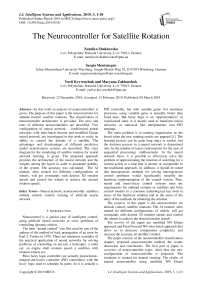The neurocontroller for satellite rotation
Автор: Nataliya Shakhovska, Sergio Montenegro, Yurii Kryvenchuk, Maryana Zakharchuk
Журнал: International Journal of Intelligent Systems and Applications @ijisa
Статья в выпуске: 3 vol.11, 2019 года.
Бесплатный доступ
In this work an analysis of neurocontrollers is given. The purpose of this paper is the neurocontroler for attitude control: satellite rotations. The classification of neurocontroller architecture is provided. The pros and cons of different neurocontrollers are described. Two configuration of neural network – feedforward neural networks with mini-batch descent and modified Elman neural network, are investigated in this work to verify its ability to control the attitude of a satellite. The advantages and disadvantage of different predictive model neurorization systems are described. The class diagram for the simulating of satellite rotation for neural network learning is given. The proposed approach provides the architecture of the neural network and the weights among the layers in order to guarantee stability of the system. The accuracy was calculated. The AI module, after trained for different configurations of wheels, will get commands with desired 3D rotation speeds and control the wheels to achieve the desired rotation speeds.
Neural network, neurocontroller, satellites, attitude control, control, training of artificial neural network
Короткий адрес: https://sciup.org/15016575
IDR: 15016575 | DOI: 10.5815/ijisa.2019.03.01
Список литературы The neurocontroller for satellite rotation
- Khuntia, S. R., Mohanty, K. B., Panda, S., & Ardil, C. (2009). A comparative study of PI, IP, fuzzy and neuro-fuzzy controllers for speed control of DC motor drive. 16
- Gundy-Burlet, K. (2004). Augmentation of an intelligent flight control system for a simulated C-17 aircraft. Journal of Aerospace Computing, Information, and Communication, 1(12), 526-542
- Parks, P. (1966). Liapunov redesign of model reference adaptive control systems. IEEE Transactions on Automatic Control, 11(3), 362-367
- Bouchard, M. (2001). New recursive-least-squares algorithms for nonlinear active control of sound and vibration using neural networks. IEEE Transactions on Neural Networks, 12(1), 135-147
- Ku, C. C., & Lee, K. Y. (1995). Diagonal recurrent neural networks for dynamic systems control. IEEE transactions on neural networks, 6(1), 144-156
- Ito, K. (2000). Gaussian filter for nonlinear filtering problems. In Decision and Control, 2000. Proceedings of the 39th IEEE Conference on (Vol. 2, pp. 1218-1223). IEEE
- Vasičkaninová, A., & Bakošová, M. (2009). Neural network predictive control of a chemical reactor. Acta Chimica Slovaca, 2(2), 21-36
- Sahu, A., & Hota, S. K. (2018, March). Performance comparison of 2-DOF PID controller based on Moth-flame optimization technique for load frequency control of diverse energy source interconnected power system. In Technologies for Smart-City Energy Security and Power (ICSESP), 2018 (pp. 1-6). IEEE.
- He, K., Zhang, X., Ren, S., & Sun, J. (2016). Deep residual learning for image recognition. In Proceedings of the IEEE conference on computer vision and pattern recognition (pp. 770-778).
- Ellery, A. A. (2017). Space Exploration Through Self-Replication Technology Compensates for Discounting in Net Present Value Cost-Benefit Analysis: A Business Case?. New Space, 5(3), 141-154.
- Izzo, D., Simões, L. F., & de Croon, G. C. (2014). An evolutionary robotics approach for the distributed control of satellite formations. Evolutionary Intelligence, 7(2), 107-118
- Briggs, F. C. (2016). Soft Computing in Aerospace. In AIAA Infotech@ Aerospace (p. 0483).
- Tamayo, A. J. M., Bustamante, P. V., Ramos, J. J. M., & Cobo, A. E. (2017). Inverse models and robust parametric-step neuro-control of a Humanoid Robot. Neurocomputing, 233, 90-103.
- Gleue, C., Eilers, D., von Mettenheim, H. J., & Breitner, M. H. (2017). Decision support for the automotive industry: forecasting residual values using artificial neural networks.
- Kar, S., Das, S., & Ghosh, P. K. (2014). Applications of neuro fuzzy systems: A brief review and future outline. Applied Soft Computing, 15, 243-259.
- Wang, J., Zheng, H., Li, Q., Wu, H., & Zhou, B. (2015, October). Prognostic for on-orbit satellite momentum wheel based on the similitude method. In Prognostics and System Health Management Conference (PHM), 2015 (pp. 1-5). IEEE.
- Lendaris, G. G. (2009, June). A retrospective on adaptive dynamic programming for control. In Neural Networks, 2009. IJCNN 2009. International Joint Conference on (pp. 1750-1757). IEEE.
- van der Smagt, P., Arbib, M. A., & Metta, G. (2016). Neurorobotics: From vision to action. In Springer Handbook of Robotics (pp. 2069-2094). Springer, Cham.
- Dias, F. M., & Mota, A. M. (2001, June). Comparison between different control strategies using neural networks. In 9th Mediterranean Conference on Control and Automation, Dubrovnik, Croatia. 1-12.
- Steinberg, M. L. (2001). Comparison of intelligent, adaptive, and nonlinear flight control laws. Journal of Guidance, Control, and Dynamics, 24(4), 693-699
- Boyko, N., Sviridova, T., & Shakhovska, N. (2018, June). Use of machine learning in the forecast of clinical consequences of cancer diseases. In 2018 7th Mediterranean Conference on Embedded Computing (MECO) (pp. 1-6). IEEE
- Shakhovska, N., Vovk, O., Hasko, R., & Kryvenchuk, Y. (2017, September). The Method of Big Data Processing for Distance Educational System. In Conference on Computer Science and Information Technologies (pp. 461-473). Springer, Cham.
- Kryvenchuk, Y., Shakhovska, N., Melnykova, N., & Holoshchuk, R. (2018, September). Smart Integrated Robotics System for SMEs Controlled by Internet of Things Based on Dynamic Manufacturing Processes. In Conference on Computer Science and Information Technologies (pp. 535-549). Springer, Cham.
- Dhanya, K. M. (2017). Dynamic Vehicle Routing Problem: Solution by Ant Colony Optimization with Hybrid Immigrant Schemes. International Journal of Intelligent Systems and Applications, 9(7), 52.
- Yang, B., & Cao, D. (2009). Action-dependent adaptive Critic design based neurocontroller for cement precalciner kiln. International Journal of Computer Network and Information Security, 1(1), 60.
- Albagory, Y., Al Raddady, F., Aljahdali, S., & Said, O. (2014). Innovative large scale wireless sensor network architecture using satellites and high-altitude platforms. International Journal of Wireless and Microwave Technologies, 4(2), 12-19.


